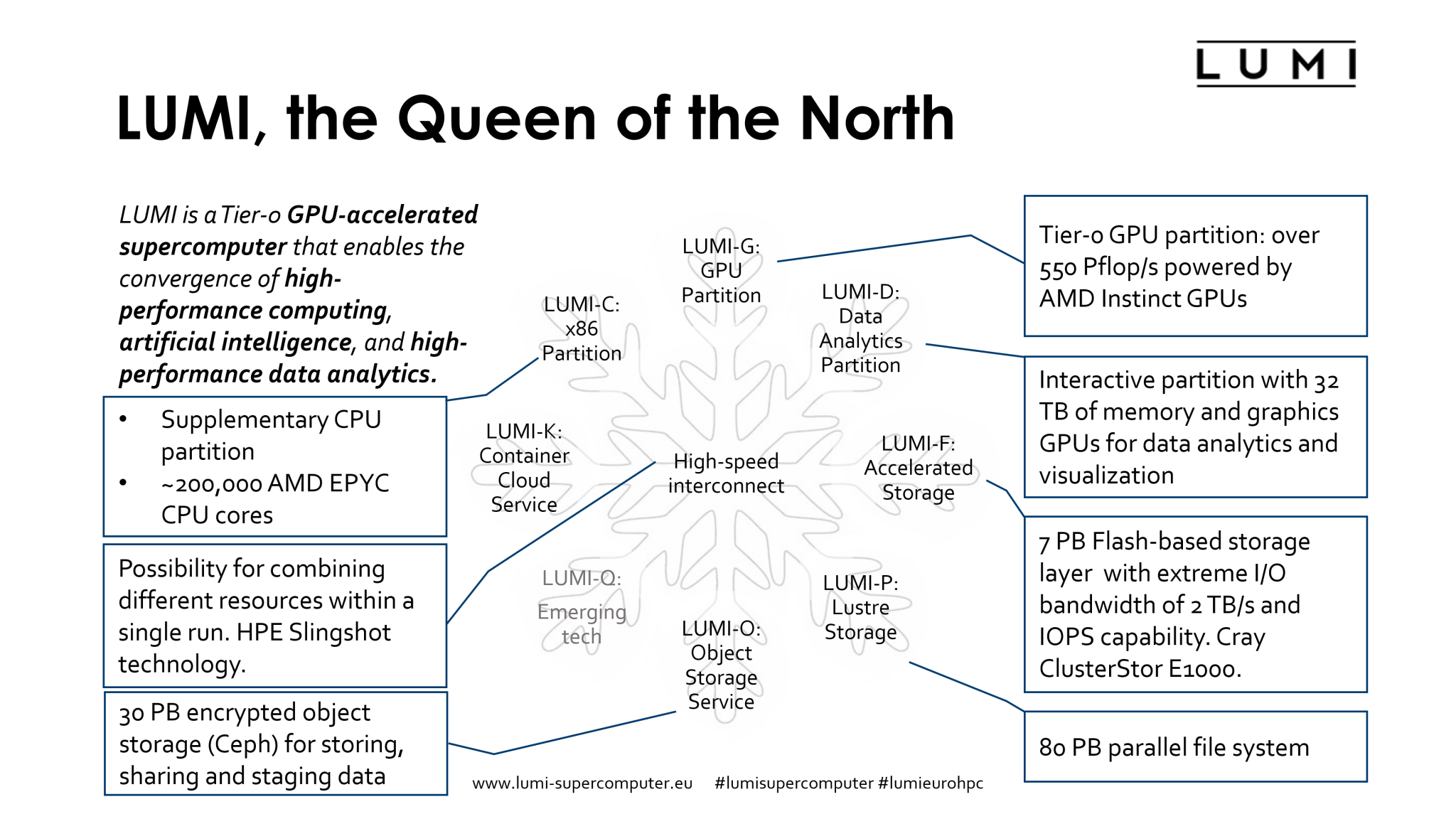All-AMD LUMI Becomes Europe's Most Powerful Supercomputer
With a taste of quantum and a truly environmental-friendly architecture.
EuroHPC 's Joint Undertaking recently deployed Europe's first pre-exascale supercomputer, LUMI, in Finland's city of Kajaani. The all-AMD build ranks as the 3rd fastest computer according to the Top500 rankings owing to its 550 Petaflops performance. It also claims the title of the world's third-greenest supercomputer, thanks to the impressive energy efficiency of the Epyc CPUs and CDNA-based MI250X GPUs. According to LUMI, achieving this performance with the world's fastest laptops would require a 23 km-high pile of them - roughly 28 times as high as the world's tallest building, Dubai's Burj Khalifa.
LUMI was engineered to derive 100 percent of its energy from renewable sources. It can be fed up to 200 MW of energy through hydropower, while the supercomputer's waste heat will be repurposed towards the Kajaani district, whose atmospheric temperatures can reach -18 Cº in winter. It's a circular energy consumption topology and opens the doors to truly environmentally-conscious, carbon-negative supercomputing.
LUMI, the result of a 10-country consortium, aims to provide researchers in Europe and across the world with a scalable platform that can supercharge climate-forward computations, medical and artificial intelligence research, and even quantum computing simulations. The underlying software is powered by AMD's ROCm software stack, which stands in contrast to NVIDIA's CUDA thanks to its open-source approach. It also features a translation mechanism that can adapt CUDA-based code to AMD's software stack with minimal software engineering efforts.

LUMI's architecture features a star-like topology, with eight partitioned nodes converging through Cray's Slingshot high-speed interconnect (200 Gb/s). One of those, LUMI-G, is purely GPU-accelerated, with no less than 10,240 AMD Instinct MI250X GPUs distributed throughout 2,560 nodes (each node featuring four GPUs and a single, 64-core AMD Epyc 7763 "Trento" CPU), with four 200 Gb/s links between GPU nodes. Each AMD Instinct MI250X features 128 GB of HBM3 VRAM (3,2 TB/s bandwidth), and is rated at 42.2 TFLOP/s of performance in HPL benchmarks. All in all, AMD's GPUs offer 432,128 TFLOP/s performance and over 1 TB of addressable VRAM.
The LUMI-C partion features CPU-based acceleration, deploying 1,536 dual-socket, 64-core AMD Trento CPUs (totaling 196,608 AMD Zen 3 cores). At the same time, another partition is dedicated to in-process workloads, offering a total of 32 TB of RAM that can fit immense datasets. As for data storage, LUMI adopted a hybrid topology: hot data is kept in an 8 PB (PetaByte) all-flash Lustre system. A total of 80 PB of classical, HDD-based storage flows through Lustre. A cloud-enabled node is responsible for keeping LUMI's power at the fingertips of any researcher across the world that features an internet connection.
Plans for LUMI's expansion include LUMI-Q, a node fully dedicated to the emerging frontier of quantum computing. LUMI sees the future as quantum-classical, building upon a hybrid HPC (High-Performance Computing)+ QC (Quantum Computing) as the place where real-world applications will find their quantum advantage. While this node still hasn't been locally installed, LUMI has so far been linked successfully with two quantum computers: the Swedish Chalmers/Wallenberg Centre for Quantum Technology QAL 900, and Finland's first quantum computer, the Helmi, operated by VTT.
However, LUMI's deployment has been affected by the ongoing semiconductor crush, and the system has been added to in phases throughout this year. The pilot launch of the system is expected in August 2022, with its supercomputing prowess opening up for general availability in September of this year. The supercomputer's footprint will take up almost 400m2 - about the size of two tennis courts. It also belongs to the heavyweight category, with around 150,000 kilograms (150 metric tons) of computing power.
Get Tom's Hardware's best news and in-depth reviews, straight to your inbox.
LUMI stands not only as Europe's crown jewel for supercomputing but is also a badge-bearer for AMD's increasingly relevant HPC chops and climate-conscious architectures, and its design stands as a testament to humanity's collaborative ingenuity.

Francisco Pires is a freelance news writer for Tom's Hardware with a soft side for quantum computing.
-
gg83 I love the carbon negative approach! This machine will pay for itself in no time. And the tech, 128gb HBM3 gpus?! AwesomeReply -
prtskg Reply
Yes, everyone involved has done good work to keep this highly efficient.gg83 said:I love the carbon negative approach! This machine will pay for itself in no time. And the tech, 128gb HBM3 gpus?! Awesome -
MasterMadBones There is no such thing as carbon negative super computing, unless it somehow captures CO2 from the atmosphere. Nevertheless, repurposing the waste heat is a very good way to deal with the fact that supercomputers use a lot of energy.Reply -
gg83 Reply
It's a fun thing to think about. Maybe it could work in Antarctica at a research center.Francisco Alexandre Pires said:If all the power for the system is derived from renewable sources, and it allows for 20% of its waste heat to be repurposed, then the equivalent amount of heat won't need to be sourced from non-renewable sources.
Hence, yes, it's carbon negative in that sense. Of course, perhaps not at installation time (carbon footprint for the hardware, manufacturing, installation, and whatnot) but over time, it will eventually reach carbon zero, and then carbon negative operation =)
